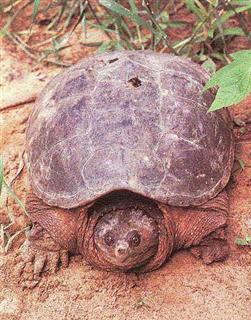Snapping Turtle
Snapper Scientific Name: Chelydra serpentina
Sat, 14th June, 2025 - 6:36 pm GMT
Sponsor Ads:

Alternative Name
Snapper Scientific Name: Chelydra serpentinaBasic Info
A moderately sized turtle, the Snapping Turtle generally averages between 7 and 9 inches in length. Their oval carapace has a serrated rear edge and ranges between shades of tan or brown to very dark brown, close to black. They often have thin caramel-colored markings on the carapace, and usually have three raised ridges (keels) that run from the neck to tail. These keels are topped by knobby protrusions, which wear down as the turtle ages. The skin of their neck, legs, and tail are varying shades of brown. The plastron, or under shell, is usually a yellowish brown color, as is the skin on the underside of the turtle. The Snapping Turtle's head is very large, and their tails are usually quite long.
Health
Ideally, Snapping Turtles should be housed outdoors when weather permits. They should have both a land and large pool area. Even though they can survive in quite cold temperatures, your turtles will be most active in water over 16 degrees Celsius. These turtles are very aggressive and have very strong jaws that could cause serious injury, so they are only recommended for experienced hobbyists and should not be handled by children. Breeding Snapping Turtles are usually sexually mature when their carapace is about eight inches long. They usually hibernate between November and March, depending on the weather in their region, and mate after hibernation in May. They generally breed between May and June, and females may be capable of storing fertile sperm over the winter without fertilization. After mating, the female Snapping Turtle lays a clutch of between 20 and 40 eggs, usually very close to the water. The eggs hatch after between 55 and 125 days, depending on the temperature and region. The sex of the hatchling turtles depends on the temperature of incubation: Temperatures above 29 degrees or below 20 degrees Celsius produce female turtles, temperatures between 23 and 24 degrees produce males, and any intermediate temperature produces hatchlings of both sexes.Habitat
Found from southern Canada through the central and eastern regions of the United States and south through Florida, Central America, and northwestern South AmericaBehavior
The unique looking Snapping Turtle is native to North America. It earns its name from its aggressive nature and incredibly strong jaws. Snapping Turtles are interesting animals, but their aggressive nature and tendency to snap at everything (from which they get their name) makes them less than ideal pets. Aquatic turtles, the Snapping Turtle can be found in almost any type of water source. They are more commonly found in ponds, lakes, and streams with muddy bottoms, in which they can burrow and hibernate. Snapping Turtles have a very high tolerance for cold, essential in the climates they are native to. Snapping Turtles have been observed underneath layers of ice. Unlike many other turtle species, the Snapping Turtle does not spend a great deal of time basking in the sun. Rather than basking, which they do only occasionally, they spend time at the murky bottoms of lakes and streams. They are not active hunters, preferring instead to lie in wait until unsuspecting prey ventures near. They often hide in mud or underwater, exposing only their eyes and nose. When the prey is within reach, the turtle strikes very quickly and drags the prey underneath the water. Snapping Turtles may occasionally feed on land, but this is not their preferred method. When encountered on land, the Snapping Turtle is usually quite aggressive. When approached, they hiss, strike and emit a musky odor from glands near the tail. They are generally very calm when in the water and will retreat from threats instead of rising to them. Snapping Turtles are solitary animals and only interact with each other when defending their territory or mating. Snapping Turtles generally live between 30 and 40 years.Origin
North, Central, and South AmericaHistory
The Snapping Turtle is found from southern Canada through the central and eastern regions of the United States and south through Florida, Central America, and northwestern South America. They are common throughout most of their range, although they are decreasing in numbers in water sources frequently visited by fishermen. Despite the large number of Snapping Turtles found in California, they are not native there, and it is illegal to release Snapping Turtles into the wild in California. Snapping Turtles are a favorite addition to stews and soups throughout much of the United States, and they were at one time an essential part of many Native American ceremonies. The Native Americans made rattles out of the shells.Common Foods
Snapping Turtles are omnivores with a gigantic and non-exclusive appetite. They will eat almost anything, including frogs, fish, snakes, crabs, insects, birds, small reptiles, and mammals, and aquatic vegetation.Sponsor Ads:
"It is greed to do all the talking but not to want to listen at all." -- Democritus.
Snapping Turtle
Coded by: BGID® | ALL RIGHTS RESERVED Copyright © 2000-2025
Disclaimer | Privacy | Report Errors / Contact | Credits
















